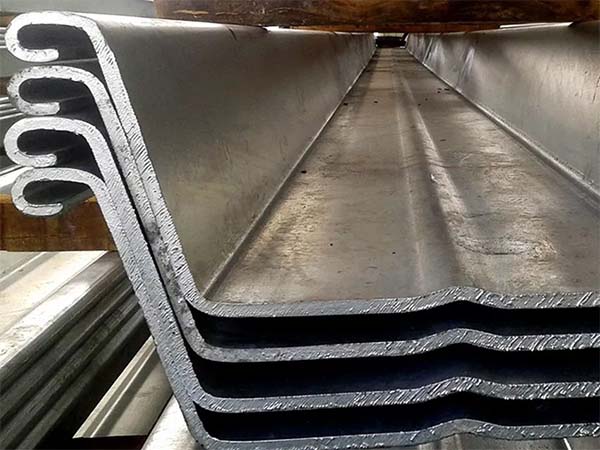Steel sheet piles are a type of steel structure with interlocking edges. Through these interlocking edges, individual sheet piles are connected together and driven into the soil to form continuous and well-sealed retaining walls or water-retaining walls. It is often used in foundation engineering to support soil, prevent landslides, hold back water or form cofferdams.
The production process and classification of steel sheet piles
The production process of steel sheet piles mainly falls into two categories: hot rolling and cold bending. Hot-rolled steel sheet piles are formed through high-temperature rolling processes, featuring high strength and tight interlocking, making them suitable for construction in deep water or hard soil layers. Cold-formed steel sheet piles are formed by continuous rolling of thin plates in cold-formed groups. They have low cost and flexible size adjustment, but their strength and water resistance are weaker than those of hot-rolled types, and they are mostly used as supplementary materials.
Steel sheet piles can mainly be classified into U-shaped steel sheet piles, Z-shaped steel sheet piles, straight steel sheet piles and composite steel sheet piles.
U-shaped steel sheet piles: The cross-section of this type of steel sheet pile is symmetrical in a U shape, with lock openings on both sides, and it has a strong bending resistance capacity. Suitable for medium-depth foundation pits and water-retaining structures.

Z-shaped steel sheet piles: The cross-section mainly presents a Z shape, with lock openings distributed on both sides of the pile body. The pile width is relatively large, and after combination, the section inertia and section modulus are large, making them suitable for deep foundation pit support.
Straight plate steel piles: The cross-section is flat, with lock openings distributed on both sides. The shape is simple and can form a relatively flat wall after connection. It is suitable for shallow support and is often used as an underground water-stop wall.
Composite sheet piles: Composed of main piles and intermediate connecting piles. The main piles are generally H-shaped steel, I-beams or box piles, mainly bearing the majority of the load. The connecting piles are mainly connecting pieces and light piles, mainly serving to stop water and make connections. It is suitable for projects of extremely high depth or high demand, and is often used in permanent structures that require high strength and durability.
The main application scenarios of steel sheet piles
Foundation pit support: A temporary support structure used during the construction of subways, tunnels, underground garages, etc.
Water conservancy projects: Commonly used for river diversion, embankment reinforcement, and fencing of water treatment facilities, etc.
Port and wharf construction: Commonly used as retaining walls, revetment walls, dry docks, and wharf structures.
Temporary projects: Enclosure during road construction and bridge foundation construction.
Common construction techniques for steel sheet piles
Individual driving method: Use a vibrating hammer or pile driving hammer to drive steel piles one by one in sequence. This method is simple to operate and has relatively low requirements for equipment, but it is prone to deviations. The subsequent driven steel piles may deviate from the design line and are suitable for short piles.
Screw-type driving method: Also known as "row driving method" or "screen driving method", this method involves pre-joining several steel piles into a group and then driving them into the soil as a whole. Usually, vibrating hammers or static pressure equipment are used. It has good overall performance, but it has higher requirements for equipment and site.
Common problems and solutions
Leakage at the lock opening: Use high-pressure grouting or add rubber waterstop.
Pile inclination: Use a hydraulic vibratory hammer to adjust the verticality.
Soil disturbance: Control the pile driving speed to reduce the excess pore water pressure.
Summary
Steel sheet piles, with their high structural strength, flexible construction, reliable waterproofing and reusability, have become one of the pillar technologies in modern geotechnical engineering, especially in the fields of hydraulic structures, temporary support and environmentally friendly enclosures, where they are irreplaceable.
